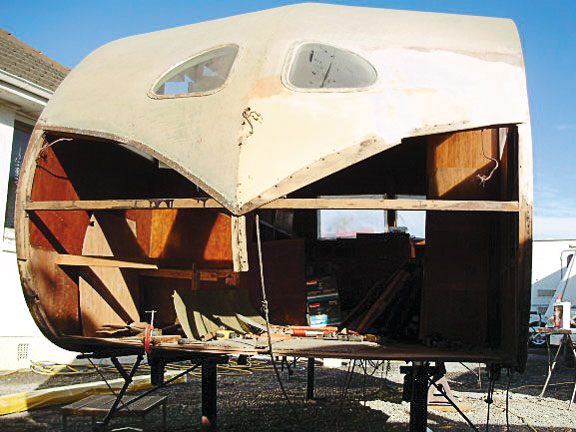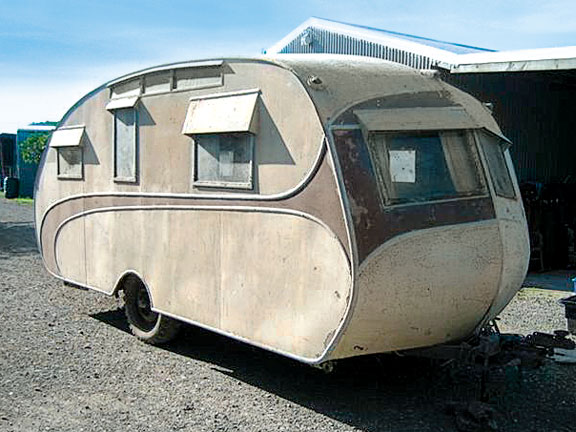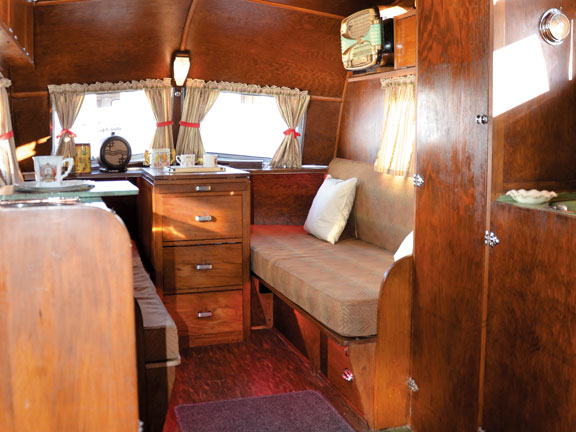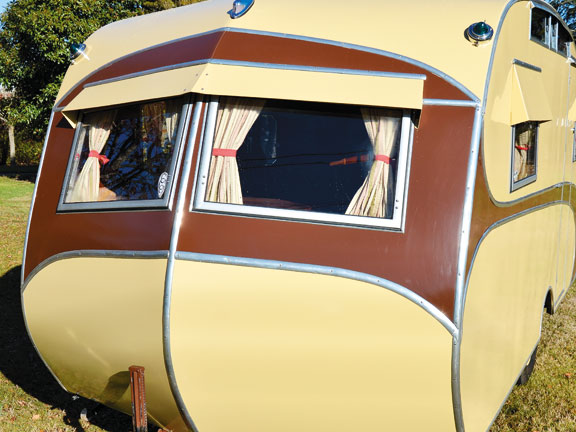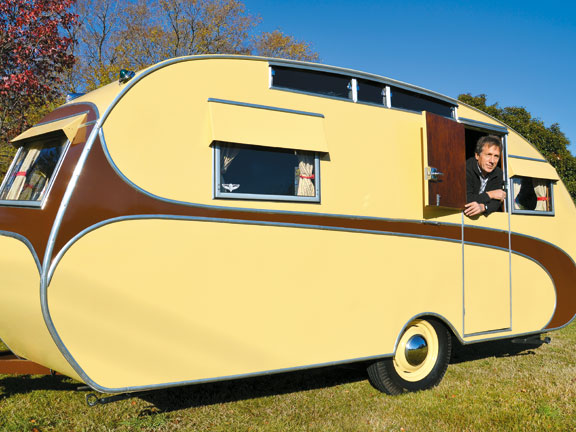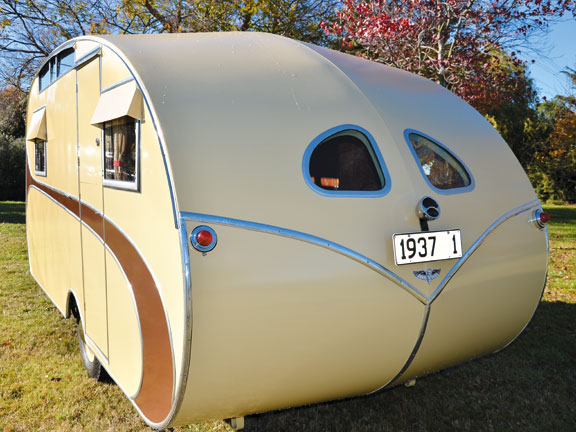The caravan belongs to Graham Hollobon, owner of Christchurch’s Affordable Caravans. The company specialises in importing and refurbishing used caravans, predominantly from the UK. But Graham also has a weakness for retro caravans and over the years he’s acquired a number of 50s-era models, mostly from New Zealand.
They include two Bellevues, a Cresta Craft, a British-built Burlingham (with lead-light windows) and – what is believed to be the only one in the country – a 1937 Tanner. Being the perfectionist he is, Graham has spared no expense in returning them to their former glory.
The Car Cruiser Caravan (CCC) has enjoyed the same pampered treatment, but getting it to factory condition – and tracing its ancestry – has taken dogged sleuth work.
Graham found the caravan on TradeMe, where it was listed under the dollar auction category. By all accounts, the seller was thrilled when the bidding reached $500, and then thought the fool who upped the ante to $1000 had lost his mind. At $5000 he thought he was obviously the victim of a practical joke. His reaction to the final sale price of $23,000 is not recorded…
Research
Before beginning a 'formal' caravan restoration project, says Graham, it's crucial to find out as much about it as possible. "If you want to return the caravan to its original, factory condition, you have to know everything about it so that you can hunt down and fit the correct parts. I didn't touch the CCC for nearly a year, until I was satisfied with my research.
"I was very lucky because it had spent the last 35 years in a barn. It was very shabby but its bones were in excellent condition. Most importantly, it was virtually complete with all its fittings. The owner bought it on a whim from an acquaintance in 1985 but never used it. He didn't know anything about its history or how it had come to New Zealand," says Graham.
CCCs were regarded as futuristic in the 30s because of their streamlined, aerodynamic styling. The company was founded by a Major Fleming-Williams who'd been a WW1 artist, providing illustrations for newspapers.
However, his real interest lay in designing aeroplanes (he was nicknamed 'Streamline Bill') and he applied the same principles to his range of caravans, hand-built in a facility in Hayes, Middlesex.
Information on Graham's specific model was non-existent. Ferreting through caravan museums and websites in the UK drew a blank, and none of the British historic caravanning associations knew of any other examples – they'd never seen one and didn't know how many were made. But they were fascinated and eventually, based on Graham's research, they produced a brochure on the model for their own records.
The most intriguing question – how (and when) the caravan came to be in New Zealand – remains a mystery.
Restoration
Restoring a vintage caravan is slow, methodical work.
"I was very lucky with the CCC," says Graham, "because it was intact, with all its bits and pieces and I have three exceptionally-skilled craftsmen, who have been around caravans all their lives."
Some of the work was straightforward – removing and polishing the chrome trims and hinges, for example, and shot-blasting and repainting the chassis. But addressing the outside panelling was trickier.
CCCs were built around a framework (a bit like a boat) and on the outside comprised mild steel sheets (below the waistline), with plywood above and on the roof. The roof panels are also covered with canvas.
"We discovered the panels were all nailed into positioned. Nails and ply are never a good combination: there's too much movement. When it came to reinstallation, I had to decide – nails or screws? To preserve authenticity, I opted, reluctantly, for nails."
The rubber seals on the windows had perished. Replacing them involved finding an extrusion as close to the original as possible, and then painstakingly shaping it with a sharp knife to get it to the right profile.
While the caravan's original wiring was in mint condition, the circuit only comprised two wires. Getting the vehicle street legal – using those two wires with the period tail lights and centre brake light – required a bit of ingenuity from a creative auto-electrician.
Inside, the delicate 'art deco' light fittings (12-volt) were in perfect condition and simply required cleaning.
Thanks to his restoration work on previous caravans, Graham has acquired a stash of rare 12-volt bulbs.
In many ways, he says, the CCC was a trailblazer – way ahead of its time.
"This model is fitted with a drums-and-shoes braking system that's activated under load, when the tow vehicle brakes, something virtually unheard of for that era. Bizarrely, the shoes sit outside the drum," Graham comments, adding that he has restored the system but doesn't use it: "it's not a heavy caravan".
Wheel bearings were perfect and he's had the axles crack-tested. Finding tyres for the 16" rims proved more difficult; it took three months to secure a set.
The CCC has been painted in its original factory colours.
Caravanning in the 30s
Stepping into the CCC gives you a fascinating glimpse of life in the 30s and an appreciation of how much caravans have evolved over 80 years. But while we might snigger from a 2012 perspective, says Graham, it's worth remembering that caravans in those days were the preserve of the wealthy: "They were largely hand-built and few could afford them," he remarks.
To enhance the sense of the period, Graham has equipped with caravan with plenty of period accessories. There's the china commemorating the (brief) succession of Edward VIII to the throne in 1936, the valve radio (it works perfectly) and – my favourite – an old pancake electric heater, itself a work of art.
'Character' is the best description of the CCC and it seems it carried an unfortunate nickname on account of its dark interior and tiny rear windows: 'the black hole of Calcutta'. It's designed as four-berth caravan (two singles up front and a fill-in double at the rear. Graham and his partner have spent one night in it: "In reality, it's a two-berth; hell, one's a squeeze!" he comments, and insulation is non-existent.
The caravan attracts huge interest wherever it appears and while he's not a vintage car enthusiast, Graham is, for the first time, considering investing in a period tow vehicle. He's already been offered a 1930 Chev and a 1937 Ford – either would be a charming match.
Feel free to make a comment or ask us a question about this story on the MCD  page.
For the latest reviews, subscribe to our Motorhomes, Caravans & Destinations magazine here.
page.
For the latest reviews, subscribe to our Motorhomes, Caravans & Destinations magazine here.
 page.
For the latest reviews, subscribe to our Motorhomes, Caravans & Destinations magazine here.
page.
For the latest reviews, subscribe to our Motorhomes, Caravans & Destinations magazine here. 
